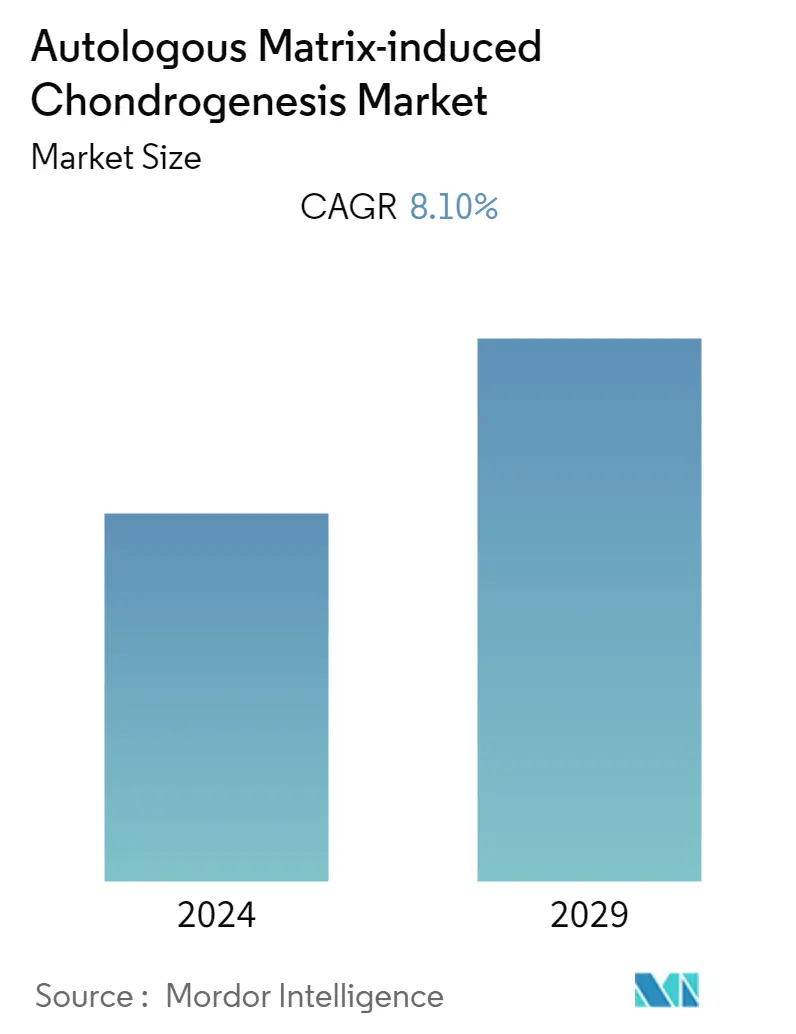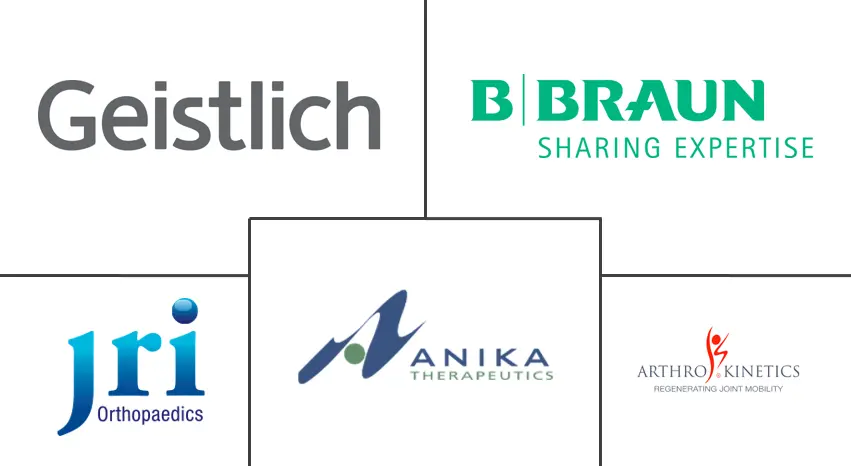Market Size of Autologous Matrix-induced Chondrogenesis Industry

| Study Period | 2019 - 2029 |
| Base Year For Estimation | 2023 |
| CAGR | 8.10 % |
| Fastest Growing Market | Asia Pacific |
| Largest Market | North America |
| Market Concentration | High |
Major Players
*Disclaimer: Major Players sorted in no particular order |
Autologous Matrix-induced Chondrogenesis Market Analysis
The autologous matrix-induced chondrogenesis market studied is expected to register a CAGR of 8.1% during the forecast period.
- COVID-19 severely impacted the autologous matrix-induced chondrogenesis market, as many orthopedic surgeries were canceled or delayed to reduce the spread of infection during the early period of the pandemic. For instance, an article published in the Medicine journal in September 2022 revealed that authorities in many countries postponed hip and knee replacement surgeries to prevent the virus from spreading. In the United States, this resulted in the cancellation of 33 thousand primary hip and knee replacements every week until 2020, with roughly 130 thousand surgeries rescheduled. As a result, COVID-19 had a significant impact on the autologous matrix-induced chondrogenesis market. However, with the resumption of operations and a decrease in COVID-19 instances, the market is predicted to recover from the COVID-19 reduction over the forecast period.
- The rising prevalence of bone and joint disorders, increasing sports and other injuries, and growing demand for minimally invasive procedures are some of the factors driving market growth. Knee and hip replacement surgeries have increased globally in recent years, with persistent wound drainage being a well-known complication that commonly leads to wound development. The increase in surgical procedures is expected to drive demand for the autologous matrix-induced chondrogenesis market. For example, as per the June 2022 report of the Canadian Institute of Health Information, approximately 110 thousand joint replacements were performed in 2020-2021, and more than 7.3 thousand were performed as day surgery, representing a four-fold increase from the previous year, which is expected to drive the growth of the market segment.
- Furthermore, research studies demonstrating the advantages offered by autologous matrix-induced chondrogenesis are likely to increase opportunities for market growth. For instance, an article published in June 2022 in PubMed revealed that AMIC is useful for treating focal chondral abnormalities in the knee. Moreover, AMIC demonstrated a higher International Knee Documentation Committee (IKDC), a lower visual analog scale (VAS) value, and a lower rate of revision compared to microfracture (MFx). Similarly, an article published in November 2022 in PubMed revealed that according to the main findings of the study, the AMIC technique could be effective in improving symptoms and function in patients with osteochondral lesions (OCLs) of the talus. Statistically significant decreases in pain and enhancements of ankle function (AOFAS/FFI) were observed. Thus, such research studies demonstrate the advantages offered by autologous matrix-induced chondrogenesis and are likely to fuel market growth.
- However, the lack of a proper reimbursement system and the scarcity of skilled professionals are expected to hinder market growth. Overall, due to the rise in the prevalence of bone and joint disorders and the increase in research studies depicting the advantages of autologous matrix-induced chondrogenesis, the studied market is likely to witness notable growth over the forecast period.
Autologous Matrix-induced Chondrogenesis Industry Segmentation
As per the scope of the report, AMIC is a single-stage cartilage regeneration approach in which a cell-free collagen matrix is implanted into a defective cartilage, combined with microfracture. These treatments have proven better outcomes as compared to conventional techniques.
The autologous matrix-induced chondrogenesis market is segmented by material (hyaluronic acid, collagen, polyethylene glycol (PEG), poly lactic-co-glycolic acid (PLGA), and other materials), application (knee cartilage, elbow cartilage, and other applications), and geography (North America, Europe, Asia-Pacific, Middle East, and Africa, South America). The report also covers the estimated market sizes and trends for 17 countries across major regions globally.
The report offers the value (in USD) for the above segments.
| By Material | |
| Hyaluronic Acid | |
| Collagen | |
| Polyethylene Glycol (PEG) | |
| Poly Lactic-co-glycolic Acid (PLGA) | |
| Other Materials |
| By Application | |
| Knee Cartilage | |
| Elbow Cartilage | |
| Other Applications |
| Geography | ||||||||
| ||||||||
| ||||||||
| ||||||||
| ||||||||
|
Autologous Matrix-induced Chondrogenesis Market Size Summary
The autologous matrix-induced chondrogenesis market is poised for significant growth, driven by the increasing prevalence of bone and joint disorders, a rise in sports-related injuries, and a growing demand for minimally invasive surgical procedures. The market experienced a setback due to the COVID-19 pandemic, which led to the postponement of numerous orthopedic surgeries. However, as operations resume and COVID-19 cases decline, the market is expected to recover and expand. Research highlighting the benefits of autologous matrix-induced chondrogenesis, such as improved outcomes in knee and talus surgeries, is anticipated to further propel market growth. Despite challenges like inadequate reimbursement systems and a shortage of skilled professionals, the market is projected to witness notable expansion over the forecast period.
North America is expected to maintain a substantial share of the autologous matrix-induced chondrogenesis market, attributed to the rising incidence of bone and joint disorders, an aging population, and increased sports injuries. The region's market growth is supported by heightened awareness of advanced treatment procedures and significant government investments in cartilage regeneration technologies. The prevalence of osteoarthritis and the demand for knee replacement surgeries are also contributing factors. The market is characterized by a few major players, including Anika Therapeutics, Inc., Arthro-Kinetics, and Zimmer Biomet Holdings, who hold significant market shares. Recent strategic acquisitions and product showcases, such as Collagen Matrix's acquisition of BV Polyganics and Rousselot's presentation of Colartix, highlight ongoing efforts to expand market offerings and address joint care needs.
Autologous Matrix-induced Chondrogenesis Market Size - Table of Contents
-
1. MARKET DYNAMICS
-
1.1 Market Overview
-
1.2 Market Drivers
-
1.2.1 Rising Prevalence of Bone and Joint Disorders
-
1.2.2 Increasing Number of Sports and Other Injuries
-
1.2.3 Growing Demand for Minimally Invasive Procedures
-
-
1.3 Market Restraints
-
1.3.1 Lack of Proper Reimbursement System
-
1.3.2 Scarcity of Skilled Professionals and Sufficient Clinical Data
-
-
1.4 Porter's Five Forces Analysis
-
1.4.1 Threat of New Entrants
-
1.4.2 Bargaining Power of Buyers/Consumers
-
1.4.3 Bargaining Power of Suppliers
-
1.4.4 Threat of Substitute Products
-
1.4.5 Intensity of Competitive Rivalry
-
-
-
2. MARKET SEGMENTATION (Market Size by Value - USD)
-
2.1 By Material
-
2.1.1 Hyaluronic Acid
-
2.1.2 Collagen
-
2.1.3 Polyethylene Glycol (PEG)
-
2.1.4 Poly Lactic-co-glycolic Acid (PLGA)
-
2.1.5 Other Materials
-
-
2.2 By Application
-
2.2.1 Knee Cartilage
-
2.2.2 Elbow Cartilage
-
2.2.3 Other Applications
-
-
2.3 Geography
-
2.3.1 North America
-
2.3.1.1 United States
-
2.3.1.2 Canada
-
2.3.1.3 Mexico
-
-
2.3.2 Europe
-
2.3.2.1 Germany
-
2.3.2.2 United Kingdom
-
2.3.2.3 France
-
2.3.2.4 Italy
-
2.3.2.5 Spain
-
2.3.2.6 Rest of Europe
-
-
2.3.3 Asia-Pacific
-
2.3.3.1 China
-
2.3.3.2 Japan
-
2.3.3.3 India
-
2.3.3.4 Australia
-
2.3.3.5 South Korea
-
2.3.3.6 Rest of Asia-Pacific
-
-
2.3.4 Middle East and Africa
-
2.3.4.1 GCC
-
2.3.4.2 South Africa
-
2.3.4.3 Rest of Middle East and Africa
-
-
2.3.5 South America
-
2.3.5.1 Brazil
-
2.3.5.2 Argentina
-
2.3.5.3 Rest of South America
-
-
-
Autologous Matrix-induced Chondrogenesis Market Size FAQs
What is the current Autologous Matrix-induced Chondrogenesis Market size?
The Autologous Matrix-induced Chondrogenesis Market is projected to register a CAGR of 8.10% during the forecast period (2024-2029)
Who are the key players in Autologous Matrix-induced Chondrogenesis Market?
Anika Therapeutics, Inc., Arthro-Kinetics, JRL Orthopaedic Ltd, Geistlich Group (Geistlich Pharma AG) and B. Braun SE are the major companies operating in the Autologous Matrix-induced Chondrogenesis Market.

